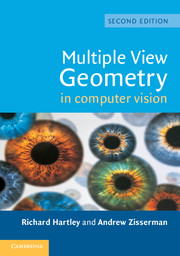Book contents
- Frontmatter
- Contents
- Foreword
- Preface
- 1 Introduction – a Tour of Multiple View Geometry
- PART 0 The Background: Projective Geometry, Transformations and Estimation
- PART I Camera Geometry and Single View Geometry
- PART II Two-View Geometry
- PART III Three-View Geometry
- PART IV N-View Geometry
- PART V Appendices
- Appendix 1 Tensor Notation
- Appendix 2 Gaussian (Normal) and χ2 Distributions
- Appendix 3 Parameter Estimation
- Appendix 4 Matrix Properties and Decompositions
- Appendix 5 Least-squares Minimization
- Appendix 6 Iterative Estimation Methods
- Appendix 7 Some Special Plane Projective Transformations
- Bibliography
- Index
Appendix 7 - Some Special Plane Projective Transformations
Published online by Cambridge University Press: 25 January 2011
- Frontmatter
- Contents
- Foreword
- Preface
- 1 Introduction – a Tour of Multiple View Geometry
- PART 0 The Background: Projective Geometry, Transformations and Estimation
- PART I Camera Geometry and Single View Geometry
- PART II Two-View Geometry
- PART III Three-View Geometry
- PART IV N-View Geometry
- PART V Appendices
- Appendix 1 Tensor Notation
- Appendix 2 Gaussian (Normal) and χ2 Distributions
- Appendix 3 Parameter Estimation
- Appendix 4 Matrix Properties and Decompositions
- Appendix 5 Least-squares Minimization
- Appendix 6 Iterative Estimation Methods
- Appendix 7 Some Special Plane Projective Transformations
- Bibliography
- Index
Summary
Projective transformations (homographies) can be classified according to the algebraic and geometric multiplicity of their eigenvalues. The algebraic multiplicity of an eigenvalue is the number of times the root is repeated in the characteristic equation. The geometric multiplicity may be determined from the rank of the matrix (H − λ I), where H is the homography and λ the eigenvalue. A complete classification is given in projective geometry textbooks such as [Springer-64]. Here we mention several special cases which are important in practical situations, and occur at several points throughout this book. The description will be for plane transformations where H is a 3 × 3 matrix, but the generalization to 3-space transformations is straightforward.
The special forms are significant because H satisfies a number of relationships (remember the only restriction a general projective transformation is that it has full rank). Since H satisfies constraints it has fewer degrees of freedom, and consequently can be computed from fewer correspondences than a general projective transformation. The special transformations also have richer geometry and invariants than in the general case.
Note that unlike the special forms (affine etc.) discussed in chapter 2, which form subgroups, the following special projectivities do not form subgroups in general since they are not closed under multiplication. They do form a subgroup if all the elements have coincident fixed points and lines (i.e. differing only in their eigenvalues).
- Type
- Chapter
- Information
- Multiple View Geometry in Computer Vision , pp. 628 - 633Publisher: Cambridge University PressPrint publication year: 2004



